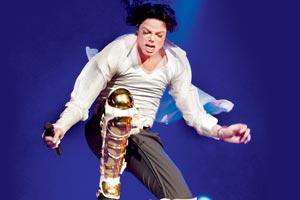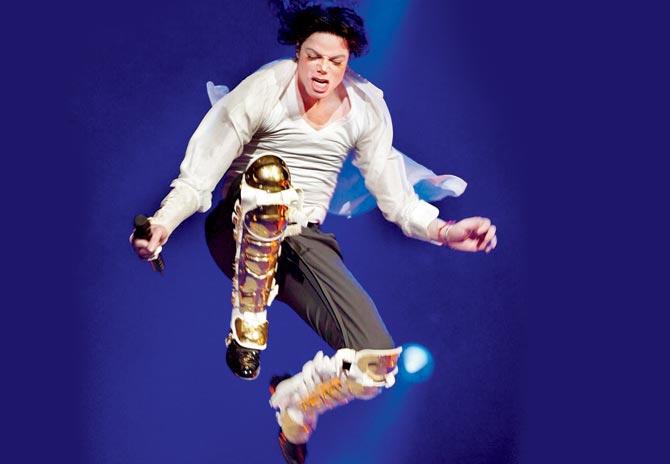It could take months for a paper to get accepted by the Journal of Neurosurgery, but the curiosity of the gravity-defying lean is such that the journal's editor accepted it within 24 hours of submission


Michael Jackson
In the last few days, neurosurgeons Dr Sandeep Mohindra, Dr Manjul Tripathi and Dr Nishant S Yagnick, have all become mini celebrities at Chandigarh's Postgraduate Institute of Medical Education & Research (PGMIR). In between attending to OPD and other hospital duties, Mohindra and Yagnick have been fielding press questions, while Tripathi, currently in the UK pursuing a short course, has recorded a video to offer his version should the media approach. And, all this fuss is thanks to a 683-word paper that the trio submitted four weeks ago to The Journal of Neurosurgery which has been able to answer the question that many generations have pondered over: How did Michael Jackson manage his gravity-defying moves?
Blood on the Dance Floor
Mohindra, 45, and Tripathi, 39, have been working together for the last seven years. While Mohindra is an Additional Professor, Tripathi is an Assistant Professor and Yagnick, a registrar, has been with the institute for three years. Mohindra says the team of neurosurgeons at the institute had been reporting a lot of dance injuries — kids or amateur dancers coming in with spinal injuries from trying to copy dance moves off YouTube videos.

Dr Nishant S Yagnick and wife Shweta are amateur dancers, and regulars at contests and reallity shows
"While our textbooks have mechanisms of injury for certain sports or postures — say if you play cricket, this is the injury you are most prone to get, or this is how you will hurt yourself if you ride a bike without a helmet — not much research has been done in the field of dance. There are people turning on their heads and B-Boying, and when they come in with injuries, we wonder how they fractured these many vertebra in this specific way?"
The study began six months ago when Tripathi called in Yagnick, asking him to participate in a research to understand the bio-mechanics of certain moves. They zoomed in on MJ's anti-gravity lean which debuted in 1987.

Smooth Criminal
In the seventh minute of the video, Smooth Criminal, in which Jackson (then 29 years old), dressed in his trademark outfit, along with a group of dancers, leans forward — without bending his legs or taking any support — at an angle of 45 degrees. For the average human, this range is 20 degrees. "Medical science," says Mohindra, "fails when Jackson starts dancing."
The first thing that the trio found out was that a patent, registered under Jackson's name, made the move partially possible. "Along with fellow inventors, MJ developed a special shoe that had a slot in the heel. The triangular slot could engage a hitch member (a metallic peg, which emerged from the stage floor at just the right time), allowing the dancer to obtain the right amount of extra support to be able to lean forward beyond physiological limits. Alas, MJ's move was an illusionary trick." Yet, says Yagnick, even with this extra support, not everyone can do an MJ.

Dr Manjul Tripathi and Dr Sandeep Mohindra
Yagnick and his wife Shweta are both amateur dancers. While he has taken training in jazz and hip hop, his wife has added ballet, modern contemporary and Indian contemporary, to her repertoire. The couple regularly participates in reality shows, in fact in February they won a Punjab state-level contest. When the research idea was mooted, the couple tried to replicate the MJ lean, but realised that even with the support of the shoes, it was impossible. "We tried the angulation against the wall. Even when we held each other's feet and legs, we could not get his angulation," says Yagnick.
Speed Demon
There was then more to this. While studying various videos and trying to replicate the move, the doctors studied the muscles that come into play. To put it simply, when the human body leans forward, it's the core muscles (or the erector spinae muscles) that act like cables to support the suspended spinal column during the forward shift, preventing the body from toppling over. However, when the body leans further, the weight is transferred from the core to the to the ankle joints, "and strain is shifted to the Achilles tendon". The paper states: "This allows for a very limited degree of forward bending from the ankle joints, while keeping a stiff straight posture — unless you are Michael Jackson. Most trained dancers with strong core strength will reach a maximum of 25° to 30°..."
![A] Drawings showing the "antigravity tilt" (>45° forward bend), the dance move introduced by Michael Jackson, in comparison to the normal limit of a human tilt (20° forward bend), as well as the conceptualized shoe designed by MJ and co-inventors. B] Shift of the fulcrum from the sacrum to the Achilles tendon in MJ](https://images.mid-day.com/images/images/2018/may/Michael-Jackson-dance-b.jpg)
A] Drawings showing the "antigravity tilt" (>45° forward bend), the dance move introduced by Michael Jackson, in comparison to the normal limit of a human tilt (20° forward bend), as well as the conceptualized shoe designed by MJ and co-inventors. B] Shift of the fulcrum from the sacrum to the Achilles tendon in MJ's antigravity tilt; the pic on the right show MJ do the tilt in Smooth Criminal. Courtesy/Journal of Neurology
What then allowed Jackson to manage what few could? Several years of training and special exercises, not unlike perhaps what sprinters such as Usain Bolt perform daily. "If you see Bolt preparing for the 100 m dash, you will see the same forward bend," says Mohindra, adding, that for the most famous dancer in the world, the idea would have been to make his Achilles Tendon so strong that the two legs could hold his 60 kg weight when he shifted his weight on them. While the average tendon can hold 10k to 15 kg, for Jackson that weight almost doubled.
Heal The World
It could take months for a paper to get accepted by the Journal of Neurosurgery, but the curiosity of the gravity-defying lean is such that the journal's editor accepted it within 24 hours of submission. Not just that. Yagnick says they have been asked to continue the research with other dancers in order to understand where injuries originate and how some people, defy the spine. Hrithik Roshan, for instance, says Mohindra has scoliosis of spine i.e. an abnormal curve. "Yet, he is one of best dancers one has seen. He has, obviously trained his muscles to challenge these bio-mechanics."
Catch up on all the latest Mumbai news, crime news, current affairs, and also a complete guide on Mumbai from food to things to do and events across the city here. Also download the new mid-day Android and iOS apps to get latest updates
 Subscribe today by clicking the link and stay updated with the latest news!" Click here!
Subscribe today by clicking the link and stay updated with the latest news!" Click here!









